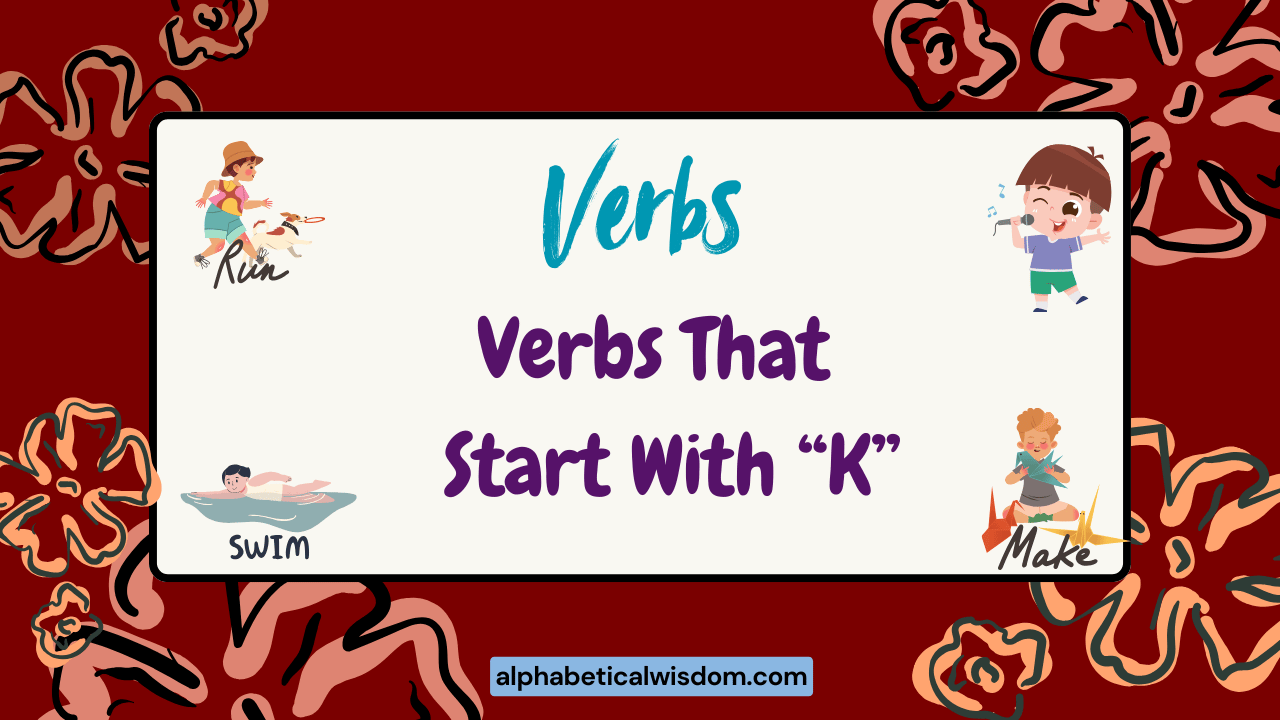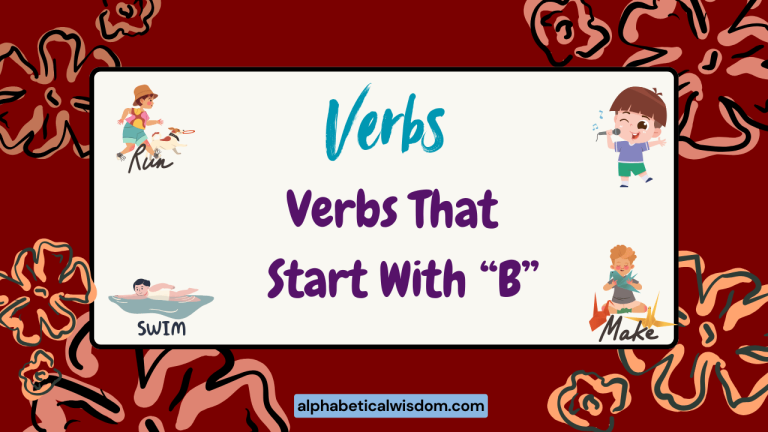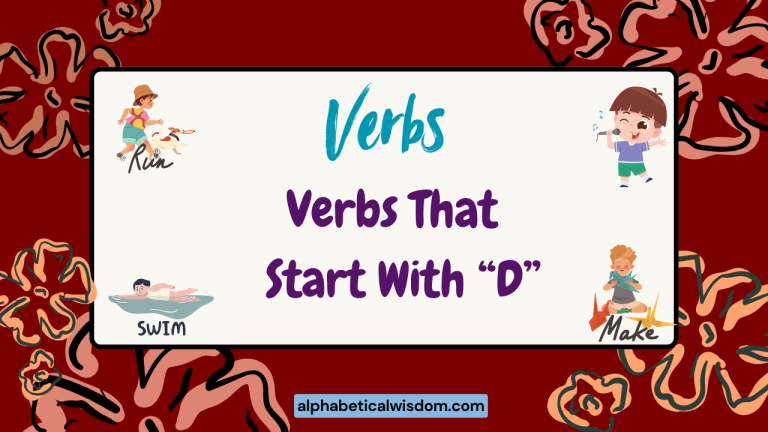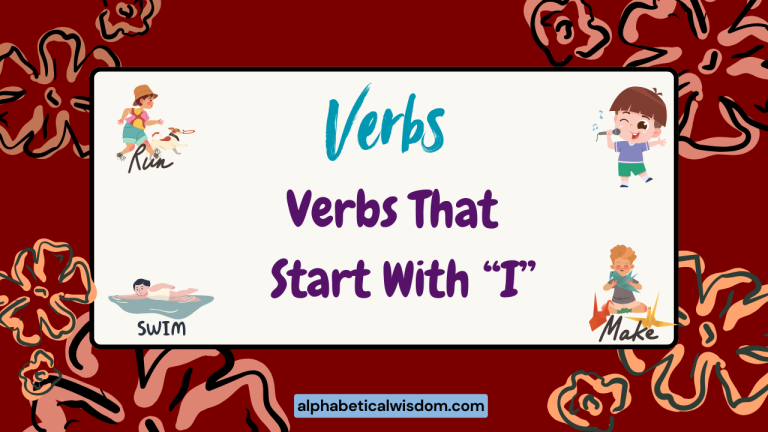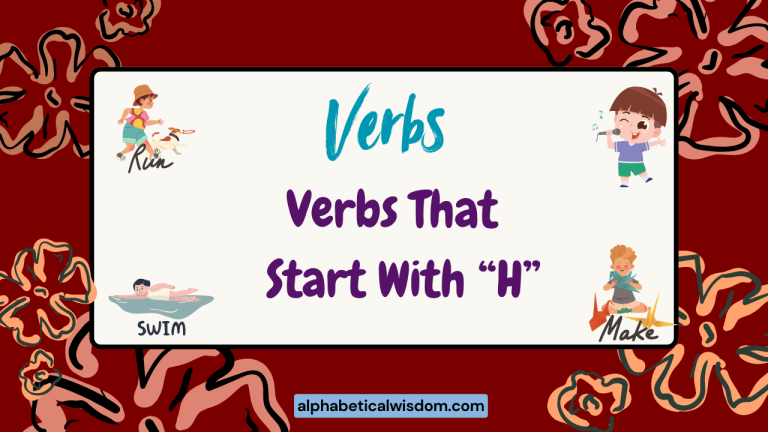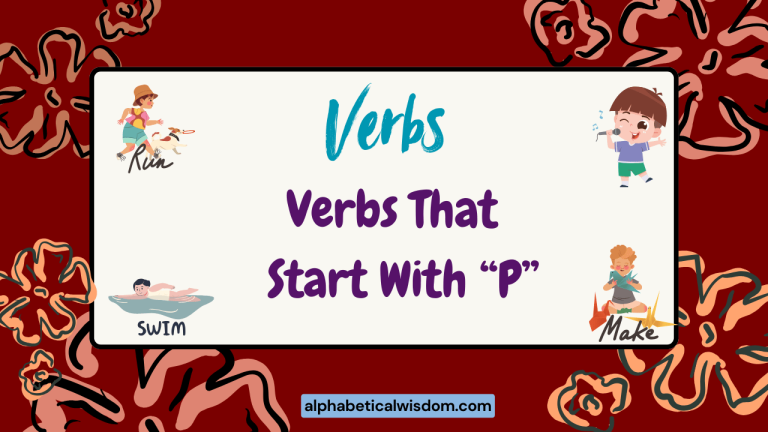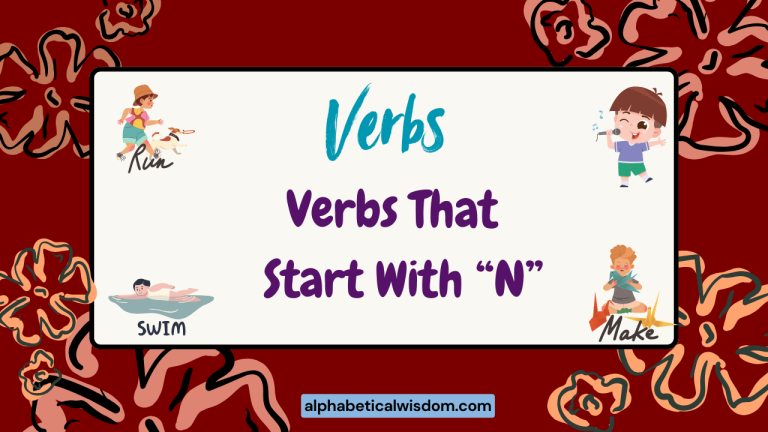Verbs Starting With K: A Comprehensive Guide to Usage & Examples
Mastering verbs is crucial for building strong English language skills. Verbs that start with ‘K’ offer a diverse range of actions, states, and processes.
Understanding these verbs enhances your ability to express yourself clearly and effectively. This guide provides a detailed exploration of verbs beginning with ‘K,’ covering their definitions, structural patterns, usage rules, and common mistakes.
This article is perfect for English language learners of all levels, from beginners to advanced speakers, as well as teachers seeking comprehensive resources.
Table of Contents
- Introduction
- Definition of Verbs Starting With K
- Structural Breakdown of Verbs Starting With K
- Types and Categories of Verbs Starting With K
- Examples of Verbs Starting With K
- Usage Rules for Verbs Starting With K
- Common Mistakes with Verbs Starting With K
- Practice Exercises
- Advanced Topics
- Frequently Asked Questions
- Conclusion
Definition of Verbs Starting With K
A verb is a word that describes an action, occurrence, or state of being. Verbs are the core of a sentence’s predicate, indicating what the subject does or is.
Verbs starting with the letter ‘K’ encompass a range of meanings, from physical actions like ‘kick’ and ‘knead’ to mental processes like ‘know’ and ‘keep in mind.’ They can be classified based on their function (action vs. stative), their relationship to objects (transitive vs. intransitive), and their conjugation patterns (regular vs. irregular).
Understanding the nuances of these verbs is essential for precise communication. For example, “kick” clearly denotes a physical action, while “know” represents a state of awareness.
Each verb carries its own specific context and implications, contributing to the overall meaning of a sentence. Recognizing these distinctions allows for more effective and accurate use of the English language.
Structural Breakdown of Verbs Starting With K
The structure of verbs starting with ‘K’ is similar to that of other English verbs. They have different forms to indicate tense (present, past, future), aspect (simple, continuous, perfect), and mood (indicative, imperative, subjunctive).
Regular verbs follow predictable patterns for forming past tense and past participle (usually by adding ‘-ed’), while irregular verbs have unique forms that must be memorized. Let’s look at how the verbs are structured.
Consider the regular verb “kiss.” Its base form is “kiss,” its past tense is “kissed,” and its past participle is also “kissed.” In contrast, the irregular verb “know” has a base form of “know,” a past tense of “knew,” and a past participle of “known.” The auxiliary verbs “be,” “have,” and “do” are often used with verbs starting with ‘K’ to create different tenses and aspects. For example, “is keeping” (present continuous), “has known” (present perfect), and “did kick” (past simple emphatic).
Types and Categories of Verbs Starting With K
Verbs starting with ‘K’ can be categorized in several ways, based on their meaning, function, and form. Understanding these categories helps in using the verbs correctly in different contexts.
Action Verbs
Action verbs describe physical or mental actions. These verbs indicate something the subject does.
Examples include ‘kick,’ ‘knead,’ ‘knock,’ ‘kill,’ and ‘keep (doing something).’
Stative Verbs
Stative verbs describe a state of being, a condition, or a mental state, rather than an action. These verbs often relate to thoughts, emotions, senses, or possession.
Examples include ‘know,’ ‘keep (a secret),’ ‘lack,’ and ‘keen (on something).’
Transitive Verbs
Transitive verbs require a direct object to complete their meaning. The action of the verb is performed on the object.
Examples include ‘kick (the ball),’ ‘know (the answer),’ ‘keep (the money),’ and ‘kill (the bug).’
Intransitive Verbs
Intransitive verbs do not require a direct object. The action of the verb is complete in itself.
Examples include ‘kneel,’ ‘knock (on the door),’ and ‘keep (going).’
Regular Verbs
Regular verbs form their past tense and past participle by adding ‘-ed’ or ‘-d’ to the base form. Examples include ‘kiss’ (kissed), ‘knock’ (knocked), and ‘kneel’ (kneeled – although some consider “knelt” an acceptable irregular form).
Irregular Verbs
Irregular verbs do not follow the standard ‘-ed’ rule for forming past tense and past participle. They have unique forms that must be memorized.
Examples include ‘know’ (knew, known), ‘keep’ (kept, kept), and ‘kneel’ (knelt, knelt – also considered a regular form in some cases).
Examples of Verbs Starting With K
The following sections provide extensive examples of verbs starting with ‘K,’ categorized by their type. These examples demonstrate how the verbs are used in different contexts and grammatical structures.
Action Verb Examples
Here are several examples of action verbs that start with ‘K’. These examples cover a range of actions and contexts.
The table below presents the verb, its usage in a sentence, and a brief explanation.
| Verb | Example Sentence | Explanation |
|---|---|---|
| Kick | He kicked the ball with all his might. | Describes a physical action of striking something with the foot. |
| Knead | The baker kneaded the dough for twenty minutes. | Describes the action of pressing and folding dough to make bread. |
| Knock | She knocked on the door before entering. | Describes the action of striking a surface to gain attention. |
| Kill | The hunter killed the deer. | Describes the action of causing death. |
| Keep (doing something) | They kept talking even after being asked to stop. | Describes the action of continuing an activity. |
| Kindle | He kindled a fire to keep warm. | Describes the action of starting a fire. |
| Kiss | They kissed goodbye at the airport. | Describes the action of touching with the lips as a sign of affection. |
| Knuckle | He knuckled down and finished the project. | Describes the action of applying oneself diligently (often used idiomatically). |
| Kayak | We kayaked down the river. | Describes the action of paddling a kayak. |
| Kid | Don’t kid yourself; it’s going to be hard work. | Describes the action of fooling or joking. |
| Kowtow | He refused to kowtow to the demands of his boss. | Describes the action of showing servile deference. |
| Kibitz | The retired men kibitzed as they watched the game. | Describes the action of offering unwanted advice or commentary. |
| Ken | That problem is beyond my ken. | Describes the range of one’s knowledge or understanding. |
| Kip | He decided to kip in the park for the night. | Describes the action of sleeping (informal). |
| Kedge | The sailors kedged the ship into deeper water. | Describes the action of moving a ship by hauling on a kedge anchor. |
| Keelhaul | The captain threatened to keelhaul the disobedient sailor. | Describes the action of dragging someone under the keel of a ship as punishment (historical). |
| Kerf | The saw kerfed the wood precisely. | Describes the action of making a cut with a saw. |
| Kink | The hose kinked and stopped the water flow. | Describes the action of forming a twist or bend. |
| Knell | The bell knelled, signaling the end of the ceremony. | Describes the action of ringing a bell slowly and solemnly. |
| Konk | He konked out after the long hike. | Describes the action of falling asleep suddenly (slang). |
| Kayo | The boxer kayoed his opponent in the first round. | Describes the action of knocking someone out in boxing (slang). |
| Kneecap | The thugs threatened to kneecap him if he didn’t pay up. | Describes the action of shooting someone in the knee (criminal slang). |
| Kludge | They had to kludge together a temporary solution. | Describes the action of creating a makeshift or inelegant solution (technical slang). |
| Kraft | The artisans krafted beautiful items. | Describes the action of creating something with skill and care. |
| Kvell | The grandmother kvelled with pride at her grandson’s graduation. | Describes the action of feeling and expressing great pride (Yiddish origin). |
Stative Verb Examples
Here are several examples of stative verbs that start with ‘K’. These verbs describe states, conditions, or mental processes.
The table below presents the verb, its usage in a sentence, and a brief explanation.
| Verb | Example Sentence | Explanation |
|---|---|---|
| Know | I know the answer to that question. | Describes a state of having knowledge or awareness. |
| Keep (a secret) | Please keep this information confidential. | Describes a state of maintaining or preserving something. |
| Lack | They lack the necessary resources to complete the project. | Describes a state of not having something. |
| Keen (on something) | She is very keen on learning new languages. | Describes a state of being enthusiastic or interested in something. |
| Keep (in mind) | Keep in mind that the deadline is approaching. | Describes a state of remembering or being aware of something. |
| Kow | They kow the local customs well. | Describes a state of knowing or understanding (archaic). |
| Ken (understand) | I ken what you mean. | Describes a state of understanding (Scottish English). |
Transitive Verb Examples
The following table provides examples of transitive verbs starting with ‘K’. These verbs require a direct object to complete their meaning.
The table includes the verb, a sentence demonstrating its use with an object, and an explanation.
| Verb | Example Sentence | Explanation |
|---|---|---|
| Kick | He kicked the ball. | ‘The ball’ is the direct object, receiving the action of kicking. |
| Know | She knows the answer. | ‘The answer’ is the direct object, representing what she knows. |
| Keep | They keep the money. | ‘The money’ is the direct object, representing what they are keeping. |
| Kill | The cat killed the mouse. | ‘The mouse’ is the direct object, receiving the action of killing. |
| Kiss | She kissed him gently. | ‘Him’ is the direct object, receiving the kiss. |
| Kindle | He kindled the fire. | ‘The fire’ is the direct object, receiving the action of kindling. |
| Knit | She knitted a scarf for her daughter. | ‘A scarf’ is the direct object, representing what was knitted. |
Intransitive Verb Examples
The following table provides examples of intransitive verbs starting with ‘K’. These verbs do not require a direct object to complete their meaning.
The table includes the verb, a sentence demonstrating its use, and an explanation.
| Verb | Example Sentence | Explanation |
|---|---|---|
| Kneel | They knelt in prayer. | The action of kneeling is complete without an object. |
| Knock | Someone knocked loudly. | The action of knocking is complete without an object. |
| Keep (going) | Just keep going, you’re almost there. | The action of continuing is complete without an object. |
| Keen | She keened in mourning. | The action of wailing is complete without an object. |
Regular Verb Examples
The following table provides examples of regular verbs starting with ‘K’. These verbs form their past tense and past participle by adding ‘-ed’.
The table includes the base form, past tense, past participle, and an example sentence.
| Base Form | Past Tense | Past Participle | Example Sentence |
|---|---|---|---|
| Kiss | Kissed | Kissed | They kissed each other goodbye. |
| Knock | Knocked | Knocked | He knocked on the door. |
| Kneel | Kneeled | Kneeled | She kneeled before the altar. |
| Kid | Kidded | Kidded | He kidded around to lighten the mood. |
Irregular Verb Examples
The following table provides examples of irregular verbs starting with ‘K’. These verbs do not follow the standard ‘-ed’ rule for forming past tense and past participle.
The table includes the base form, past tense, past participle, and an example sentence.
| Base Form | Past Tense | Past Participle | Example Sentence |
|---|---|---|---|
| Know | Knew | Known | I knew the answer yesterday; it is now known to everyone. |
| Keep | Kept | Kept | He kept the secret safe; it has been kept for years. |
| Kneel | Knelt | Knelt | She knelt before the altar. |
Usage Rules for Verbs Starting With K
Correct usage of verbs is essential for clear and effective communication. Here are some important rules to keep in mind when using verbs starting with ‘K’.
Tense Agreement
Verbs must agree in tense with the context of the sentence. For example, if the sentence is about the past, the verb should be in the past tense.
Maintaining consistent tense is crucial for conveying accurate information and avoiding confusion.
Example: Incorrect: Yesterday, I know the answer. Correct: Yesterday, I knew the answer.
Subject-Verb Agreement
Verbs must agree in number with their subject. Singular subjects take singular verbs, and plural subjects take plural verbs.
This agreement is fundamental to grammatical correctness. A singular subject requires a singular verb form, while a plural subject requires a plural verb form.
Example: Incorrect: He keep the book. Correct: He keeps the book.
Active and Passive Voice
Verbs can be in the active or passive voice. In the active voice, the subject performs the action.
In the passive voice, the subject receives the action. The choice between active and passive voice depends on the emphasis you want to place in the sentence.
Example: Active: The dog kicked the ball. Passive: The ball was kicked by the dog.
Mood (Indicative, Imperative, Subjunctive)
Verbs can express different moods, including indicative (statements of fact), imperative (commands), and subjunctive (hypothetical situations or wishes). Each mood has specific grammatical forms and usage rules.
Example: Indicative: I know the answer. Imperative: Keep quiet! Subjunctive: I wish I knew the answer.
Common Mistakes with Verbs Starting With K
Even experienced English speakers sometimes make mistakes with verbs. Here are some common errors to watch out for when using verbs starting with ‘K’.
| Incorrect | Correct | Explanation |
|---|---|---|
| I knowed the answer. | I knew the answer. | ‘Know’ is an irregular verb; the past tense is ‘knew,’ not ‘knowed.’ |
| He keep the secret. | He keeps the secret. | The verb must agree with the singular subject ‘he.’ |
| She kneeled down. | She knelt down. | ‘Kneel’ is an irregular verb; the past tense is ‘knelt,’ not ‘kneeled.’ Although ‘kneeled’ is sometimes accepted. |
Practice Exercises
Test your understanding of verbs starting with ‘K’ with these practice exercises. Each exercise focuses on different aspects of verb usage.
Exercise 1: Fill in the Blanks
Fill in the blanks with the correct form of the verb in parentheses.
| Question | Answer |
|---|---|
| 1. She __________ (know) the answer to the question. | 1. knows |
| 2. They __________ (keep) the secret for many years. | 2. kept |
| 3. He __________ (kick) the ball into the goal. | 3. kicked |
| 4. We __________ (kneel) in prayer every night. | 4. kneel |
| 5. I __________ (keep) in mind what you said. | 5. keep |
| 6. The baker __________ (knead) the dough. | 6. kneaded |
| 7. Someone __________ (knock) on the door. | 7. knocked |
| 8. She __________ (kiss) her child goodnight. | 8. kissed |
| 9. They __________ (kill) the engine. | 9. killed |
| 10. I __________ (ken) what you mean. | 10. ken |
Exercise 2: Correct the Errors
Identify and correct the errors in the following sentences.
| Question | Answer |
|---|---|
| 1. I knowed the answer yesterday. | 1. I knew the answer yesterday. |
| 2. He keep the book on the shelf. | 2. He keeps the book on the shelf. |
| 3. She kneeled down to pray. | 3. She knelt down to pray. |
| 4. They is keep the secret safe. | 4. They are keeping the secret safe. |
| 5. We kicked the ball with our foots. | 5. We kicked the ball with our feet. |
| 6. She know all the answers. | 6. She knows all the answers. |
| 7. He keeped the money in his wallet. | 7. He kept the money in his wallet. |
| 8. They is going to kick the bucket soon. | 8. They are going to kick the bucket soon. |
| 9. I am knowing the answer now. | 9. I know the answer now. |
| 10. You kneels before the king. | 10. You kneel before the king. |
Exercise 3: Sentence Construction
Construct sentences using the given verbs starting with ‘K’.
| Verb | Example Sentence |
|---|---|
| 1. Know | 1. I know that she is telling the truth. |
| 2. Keep | 2. Please keep the noise down; I’m trying to work. |
| 3. Kick | 3. The player kicked the ball over the fence. |
| 4. Kneel | 4. The knight knelt before the queen. |
| 5. Kindle | 5. They kindled a fire to stay warm in the forest. |
| 6. Kiss | 6. The couple kissed at the end of the movie. |
| 7. Knock | 7. Don’t forget to knock before entering the room. |
| 8. Kill | 8. He killed the spider with a rolled-up newspaper. |
| 9. Knead | 9. The chef kneaded the dough with expert precision. |
| 10. Ken | 10. That’s beyond my ken, I’m afraid. |
Advanced Topics
For advanced learners, understanding phrasal verbs and idiomatic expressions with verbs starting with ‘K’ can further enhance their language skills.
Phrasal Verbs with K
Phrasal verbs are combinations of a verb and a preposition or adverb, which create a new meaning. Examples with ‘K’ include ‘keep on,’ ‘keep up,’ and ‘kick off.’ For example, “keep on” means to continue, “keep up” means to maintain pace, and “kick off” means to start.
Example: They kept on singing despite the rain. The team needs to keep up their training. The meeting will kick off at 9 AM.
Idiomatic Expressions with K
Idiomatic expressions are phrases whose meaning is not predictable from the literal meanings of the words. Examples with ‘K’ include ‘kick the bucket’ (to die) and ‘keep someone on their toes’ (to keep someone alert and ready).
Understanding these idioms adds color and depth to your language.
Example: He’s afraid to kick the bucket before seeing his grandchildren grow up. The challenging project kept everyone on their toes.
Frequently Asked Questions
Here are some frequently asked questions about verbs starting with ‘K’.
- Are all verbs starting with ‘K’ action verbs?
No, not all verbs starting with ‘K’ are action verbs. Some are stative verbs that describe states of being or mental processes, such as ‘know’ and ‘keep (a secret).’ - How do I know if a verb starting with ‘K’ is transitive or intransitive?
A transitive verb requires a direct object to complete its meaning, while an intransitive verb does not. If the verb’s action is performed on an object, it is transitive. If the action is complete in itself, it is intransitive. - What is the difference between ‘kneel’ and ‘knelt’?
‘Kneel’ is the base form of the verb. ‘Kneeled’ is the regular past tense form, while ‘knelt’ is the irregular past tense form. Both are acceptable, but ‘knelt’ is more commonly used. - How can I improve my usage of verbs starting with ‘K’?
Practice using the verbs in different contexts, read widely to see how they are used by native speakers, and pay attention to common mistakes. Focus on understanding the nuances of each verb and its appropriate usage. - Are there any regional variations in the usage of verbs starting with ‘K’?
Yes, some verbs starting with ‘K’ may have regional variations in usage or meaning. For example, the verb ‘ken’ (to know) is more commonly used in Scottish English. - What are some common phrasal verbs that start with the verb ‘keep’?
Some common phrasal verbs that start with ‘keep’ include ‘keep up,’ ‘keep on,’ ‘keep out,’ ‘keep away,’ and ‘keep back.’ Each has a distinct meaning and usage. - How do I avoid making mistakes with subject-verb agreement when using verbs starting with ‘K’?
Pay close attention to the subject of the sentence and ensure that the verb agrees in number (singular or plural). Remember that singular subjects take singular verbs, and plural subjects take plural verbs. - Can you provide some examples of idiomatic expressions using verbs starting with ‘K’?
Examples include ‘kick the bucket’ (to die), ‘keep someone on their toes’ (to keep someone alert and ready), and ‘know something inside out’ (to know something very well). - How does the tense of a sentence affect verbs starting with ‘K’?
The tense of the sentence dictates the form of the verb. For example, in the past tense, ‘know’ becomes ‘knew,’ and ‘keep’ becomes ‘kept.’ Ensure that the verb tense aligns with the time frame of the sentence. - What is the difference between active and passive voice when using verbs starting with ‘K’?
In the active voice, the subject performs the action (e.g., “He kicked the ball”). In the passive voice, the subject receives the action (e.g., “The ball was kicked by him”). Choose the voice that best emphasizes the intended focus of the sentence.
Conclusion
Mastering verbs starting with ‘K’ is an important step in improving your English language proficiency. By understanding their definitions, structural patterns, usage rules, and common mistakes, you can use these verbs accurately and effectively.
Remember to practice regularly and pay attention to the context in which these verbs are used.
Continue to expand your vocabulary and grammar knowledge to enhance your communication skills. With consistent effort and attention to detail, you can achieve fluency and confidence in using the English language.
Remember to utilize resources like dictionaries, grammar guides, and practice exercises to reinforce your learning. Happy learning!
